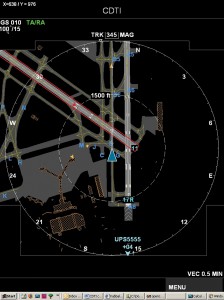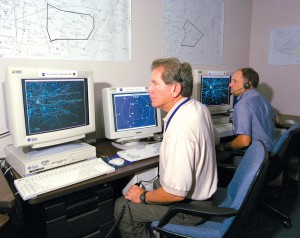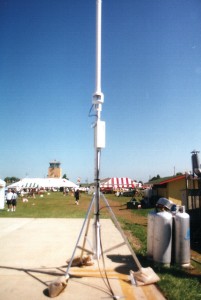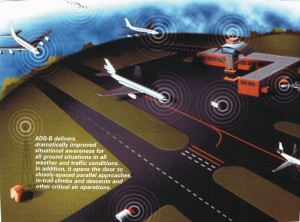By Henry M. Holden

Cockpit display image of Louisville Intl Airport-Standiford Field (SDF) using the ACSS SafeRoute system UPS will be installing throughout their fleet next year. As well as other features, the system will alert a pilot to traffic on the airport surface.
“The number of air passengers will double over the next 15 years, reaching one billion by the year 2015,” said a 1999 FAA study. Almost halfway to that date, there’s a new and more alarming prediction based on the emergence of very light jets. According to the Federal Aviation Administration’s Joint Planning and Development Office, if only two percent of airline passengers opt to switch to the four- to six-passenger VLJs, the number of aircraft in the system will triple by 2025.
Ten years ago, the Cargo Airlines Association, in cooperation with the FAA and UPS Technologies, began developing a possible solution to the looming air traffic crisis, an Automatic Dependent Surveillance-Broadcast system. That development culminated in prototype equipment that was tested and demonstrated in 26 all-cargo UPS aircraft in July 1999. Following successful trials in Alaska, on the East Coast and at airports in Louisville and Memphis, the system is now ready for wider implementation.
ADS-B is a flight deck-based merging and spacing system, as well as a surface management system that displays airborne and runway traffic, weather, flight information and motion vectors to ground receivers and other aircraft. The system depends on a WAAS-capable GPS to determine an aircraft’s precise location in space, and combines with other information such as aircraft type, speed and flight number. The digital code containing this information is updated several times a second and broadcasts from the aircraft on a discreet frequency via a data link.
Unlike conventional radar, ADS-B works in mountainous areas, at low altitudes, in remote areas and on the ground, so it can be used to monitor traffic on taxiways and runways and can be useful in preventing runway incursions.
“ADS-B allows aircraft to become part of the infrastructure by providing ground level tracking that minimizes the risk of surface incursions,” said Karen Lee, director of operations for UPS Technologies. “With the SMS application and a moving surface map in the cockpit, 95 percent of the risk of runway incursion is removed.”
ADS-B promises a number of technical advantages over the current radar-transponder combination. An air traffic controller gives a pilot a command and then waits up to 12 seconds for a radar sweep to see if the pilot has responded. ADS-B doesn’t need to interrogate targets to display them, but instead displays almost immediately the X and Y position of the aircraft.

Top: ADS-B makes it easy to integrate weather, terrain and other flight and traffic information in a single information-rich display. Below: Advanced NASA symbology displays flight plan and navigation information and more.
The FAA and others believe ADS-B will ultimately replace its aging secondary radar network (military radar will likely remain since it has other applications), which costs about $150 million annually to maintain and would cost an estimated $2.5 billion to upgrade. By contrast, the first phase of the ADS-B project will cost $600 million, half paid by the federal government and half by the users of the national air space. It’s estimated that the entire ADS-B system will cost $30 million annually to operate and maintain, according to FAA officials.
The FAA isn’t promoting ADS-B as a “big bang” event that will, with the flick of a switch in 2025, suddenly shut down the old system and turn on a new ATC world that relieves the air traffic crisis. ADS-B’s progress will be incremental.
The background chatter surrounding ADS-B was kicked up a notch in May, as the FAA and aviation industry representatives promoted the system before a national media audience at FAA headquarters.
“Several benefits will be derived from implementing the ADS-B system,” said FAA Administrator Marion Blakey. “Those include increased capacity resulting from reduced aircraft separation distances, the ability to handle the same number of flights under instrument conditions as under visual conditions, and a common situational awareness for controllers and pilots.”
The FAA has reserved $80 million for fiscal year 2007, to begin the initial implementation of ADS-B. UPS and Aviation Communication & Surveillance Systems, in conjunction with Boeing, the FAA and the Louisville Regional Airport Authority, are moving forward with implementation, and the funds include the continuing support of the 40 ADS-B ground stations and infrastructure already installed along the East Coast and Alaska.

NASA air traffic control design teams have spent the last several years studying the impact of ADS-B on the current system. ADS-B will give ATC more accurate and timely information.
The initial phase of the merging and spacing system is planned to be implemented in UPS revenue flights, during its United States West Coast arrival bank operations into Louisville International Airport-Standiford Field (SDF) via continuous descent arrival procedures.
Continuous descent arrivals are arrival procedures specifically designed to keep an aircraft at idle or near idle power during the entire arrival until the final approach fix.
“CDAs will result in significant time and fuel savings and noise and emissions reductions, but this isn’t your normal approach,” said Karen Lee. “Normally, the ATC gives pilots dive and drive instructions. ADS-B won’t compute the descent point, but it will give the pilot the optimum speed and compute the M&S distance. The CDA eliminates step-down altitudes, the associated changing vectors and power increases. It’s critical for the success of CDAs that there is little or no vectoring during the procedure to maintain the arrival stream.”
Different carriers at other locations will apply the equipment and procedures used by UPS as the program evolves. Later, M&S implementations will include operations in high-density traffic areas with numerous carriers participating. At this later stage, ATC is expected to have the sequencing and spacing tools, and is expected to coordinate across facility boundaries and among airline operations centers.

Once ADS-B is implemented, the big radar dish will be gone. This antenna is part of the ground equipment ADS-B will use.
Lee said that 107 UPS aircraft have been fully equipped with ADS-B, providing the company with enhanced capacity and greater efficiency at its SDF base of operations.
“Some of the fleet will require display updates, and some of the older airplanes will need new displays,” Lee said. “We’re beginning to swap displays, and that phase should be completed by July 2007.”
Lee said that as a pilot, she knows that the technology works.
“We’re already living in the future and can see that it’s a very bright place,” she said.
UPS will use the MITRE Corp., and NASA developed Airline Based Enroute Sequencing and Spacing tool to allow total scheduling of all aircraft inbound to SDF. The ABESS system recently had a successful initial test in the UPS airline operations centers, and is expected to become operational later this year.
“The ABESS system will build a schedule of all inbound aircraft within a defined time horizon and send airspeeds to be flown to each aircraft, via data link, to maintain the schedule,” said Lee. “Once the aircraft are within ADS-B range of one another, tactical merging and spacing by each aircraft will begin to achieve the fine-tuned intervals at the runway.”
For those aircraft not yet airborne but within the relevant time horizon, the surface management system will predict when the aircraft will be ready to push back and takeoff using various AOC inputs (e.g. crew on board, mechanically ready, percentage loaded, etc.). The FAA plans to install 400 ADS-B ground stations (each about the size of a refrigerator) by 2014, and retire more than 125 ATC radars.
“ADS-B is the backbone of the Next Generation Air Transportation System, which is being designed to triple air traffic in the U.S. by 2025,” Blakey said.
Full deployment throughout the national air system is expected by 2014, but the FAA estimates that the “full evolution” of ADS-B will take at least 20 years.

ADS-B is portable, so it can go places stationary radar can’t. This equipment was first demonstrated in 1999.
The M&S application is currently scheduled for FAA certification in mid-2007, on UPS Boeing 757 aircraft using ACSS surveillance processors and transponders, and Boeing Class III electronic flight bags. Other aircraft types in the UPS fleet will soon follow. The SMS system is now operational at the UPS hub at SDF and ADS-B surveillance from other UPS airports will be added.
The class III flight bag is an information system with two independent computer hard drives, coupled to a specially constructed video display. Its class III rating means it meets the most stringent certification requirements of the FAA.
ADS-B will also benefit offshore helicopter operations in the Gulf of Mexico, where an average of 650 helicopters operate on any given day, most flying at altitudes below radar. In early June, the FAA committed to installing ADS-B equipment to cover the Gulf of Mexico, in large part because of a $100 million incentive from the helicopter industry, which plays a major role in Gulf oil operations.
According to the Helicopter Association International, helicopter operators will supply manpower, facilities and free flights to get the system up and running. The Gulf project will be the first widespread implementation of the technology.
“I believe that due to the very nature of helicopter operations, which involve low-altitude, off-airport, remote-location, all-weather situations, our segment of the aviation community stands to reap the greatest rewards from the ADS-B technology,” HAI President Rick Zuccaro said. “Accordingly, HAI will be exploring the potential for ADS-B benefits to other segments of our industry, such as helicopter emergency medical services, corporate services and utility operations.”
Part of the ADS-B evolution will be the impact on general aviation. The FAA plans to use two types of data links in its ADS-B installations. One, for GA aircraft, will be equipped with Universal Access Transceiver equipment 960 MHz., +/- 2-3 MHz (similar to that used in the FAA’s successful trial in Alaska), and another for airliners using Mode S transponders on 1090 MHz, as they do in Europe.
While it seems inevitable that ADS-B will become mandatory, that doesn’t mean an immediate new expense for GA pilots.
“It won’t be required aboard GA aircraft until it’s affordable and available everywhere,” said Phil Boyer, president of the Aircraft Owners and Pilots Association. “Our goal will be to bring the advantages of ADS-B to the cockpit 10 years from now, at no greater cost than today’s Mode C transponder (about $2,000)—with weather and traffic displays as added bonuses.”
Lee said the airlines’ cost for ADS-B will depend on what applications carriers choose.
“All new airplanes will come with the ADS-B out (broadcast) application already installed (GPS derived position to ATC and other aircraft),” she said. “Some older aircraft will need a $5,000 upgrade.”

With ADS-B, all aircraft digitally communicate with each other, approach control and ground control.
Blakey said it will be up to the aircraft operators to decide whether they want to invest in the ADS-B in (receive), and use the cockpit display to show the position of the other aircraft.
“The surveillance processor will run $75,000 to $125,000, but the class III electronic flight bag, which UPS is installing, gives a carrier flexibility in applications,” Lee said. “The most significant may be the fuel savings, which is the result of the M&S application. Those savings alone may pay for the package.”
While the NGATS plan may be the best proposal to date to address the burgeoning air traffic crisis in the United States, it cannot be solely a U.S. solution. Global air traffic management is necessary, and the JPDO has been working with Eurocontrol, the European Single Sky initiative and others who are facing the same issues. They recently agreed to rely on the Mode-S Extended Squitter function on 1090 MHz. in international airspace, an important savings for both Boeing and Airbus, who want to equip their airplanes with just one data link, not two.
Is ADS-B the answer to the looming air traffic congestion? Only time will tell, but based on the current GPS technology, such as moving maps, TCAS and other technology, it has enormous potential. Challenges lie ahead, such as developing the airport infrastructure to meet future demand, establishing an effective security system without limiting mobility or civil liberties, establishing user-specific situational awareness, developing a comprehensive proactive safety management approach and reaching a global commonality of equipment and operations.











